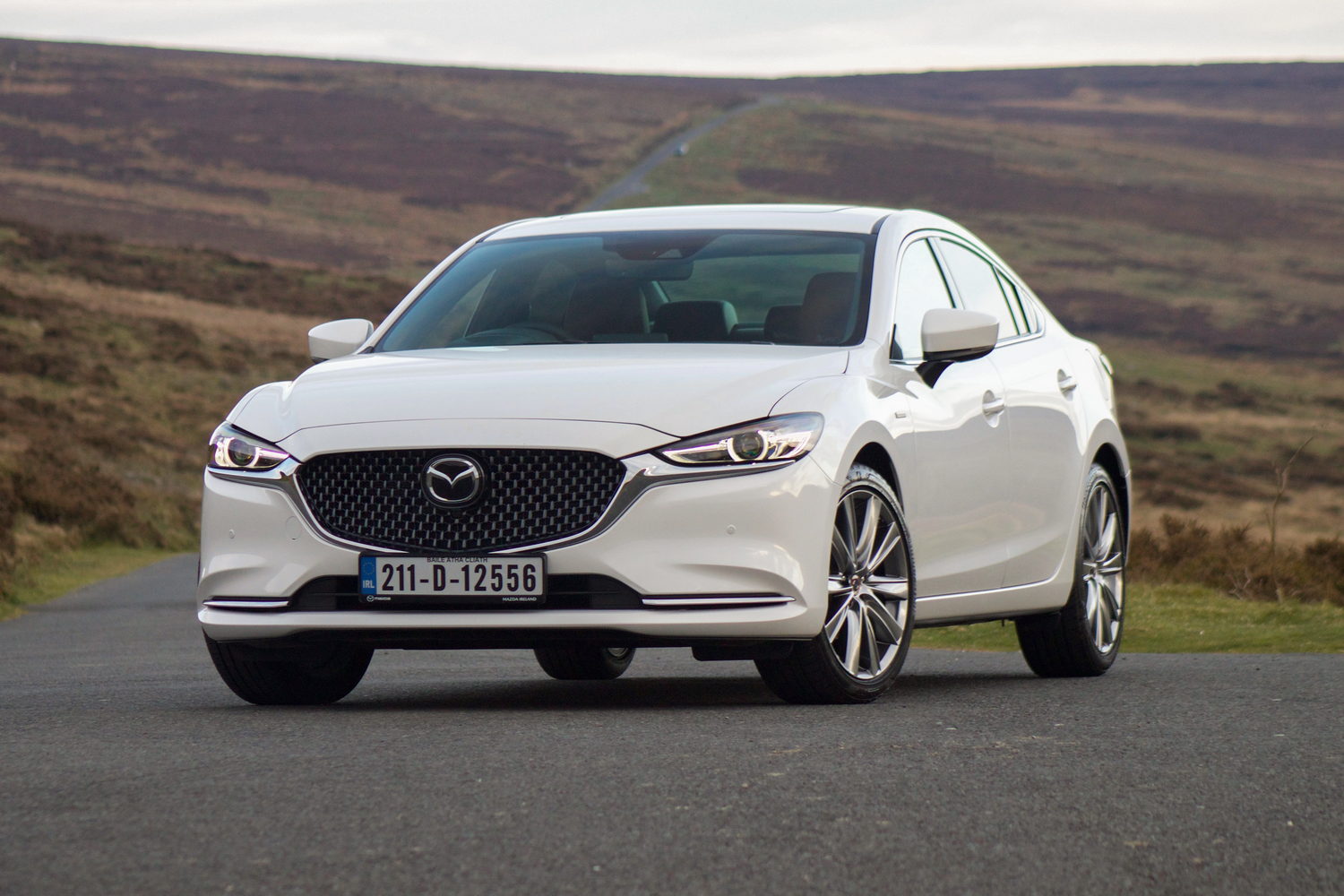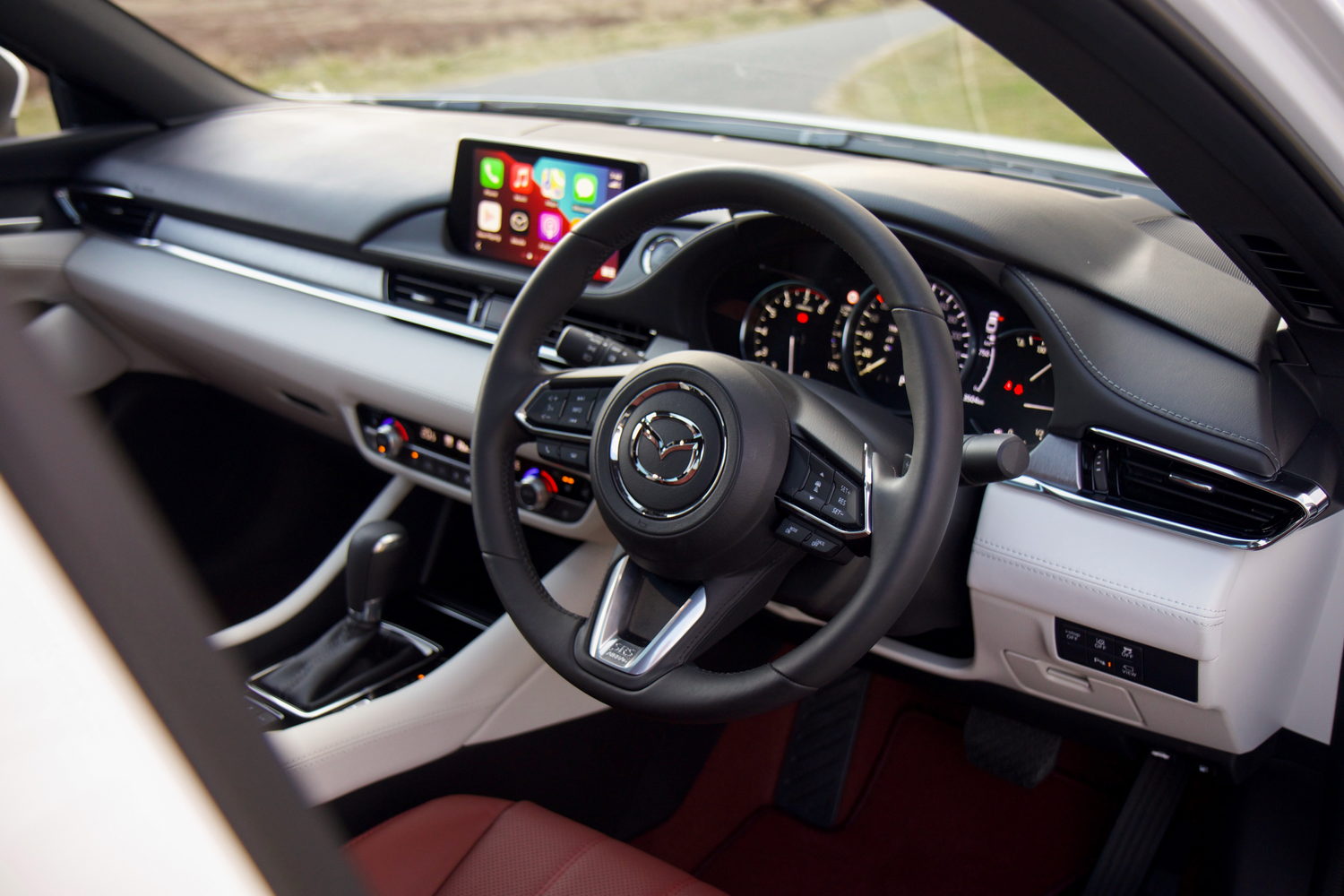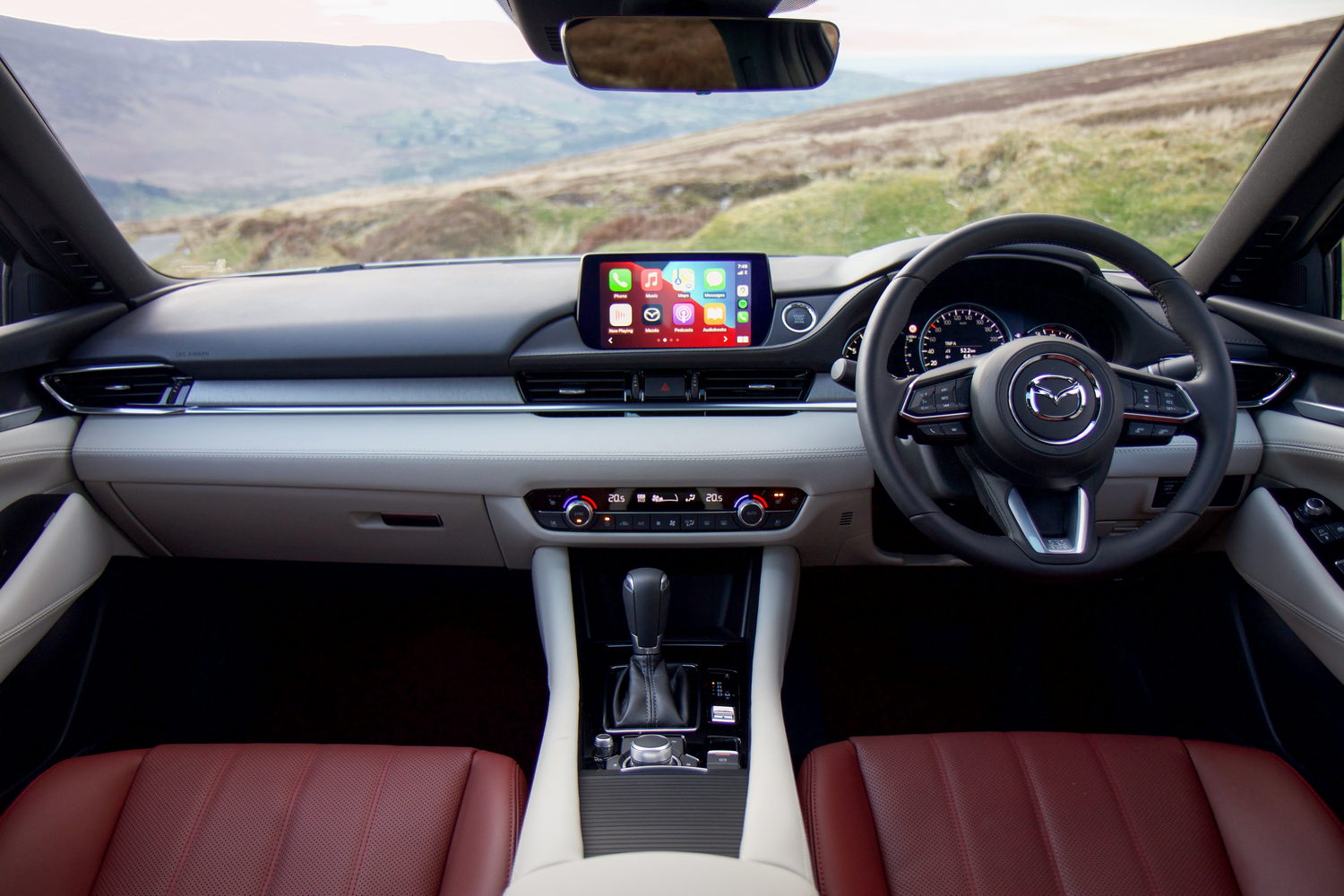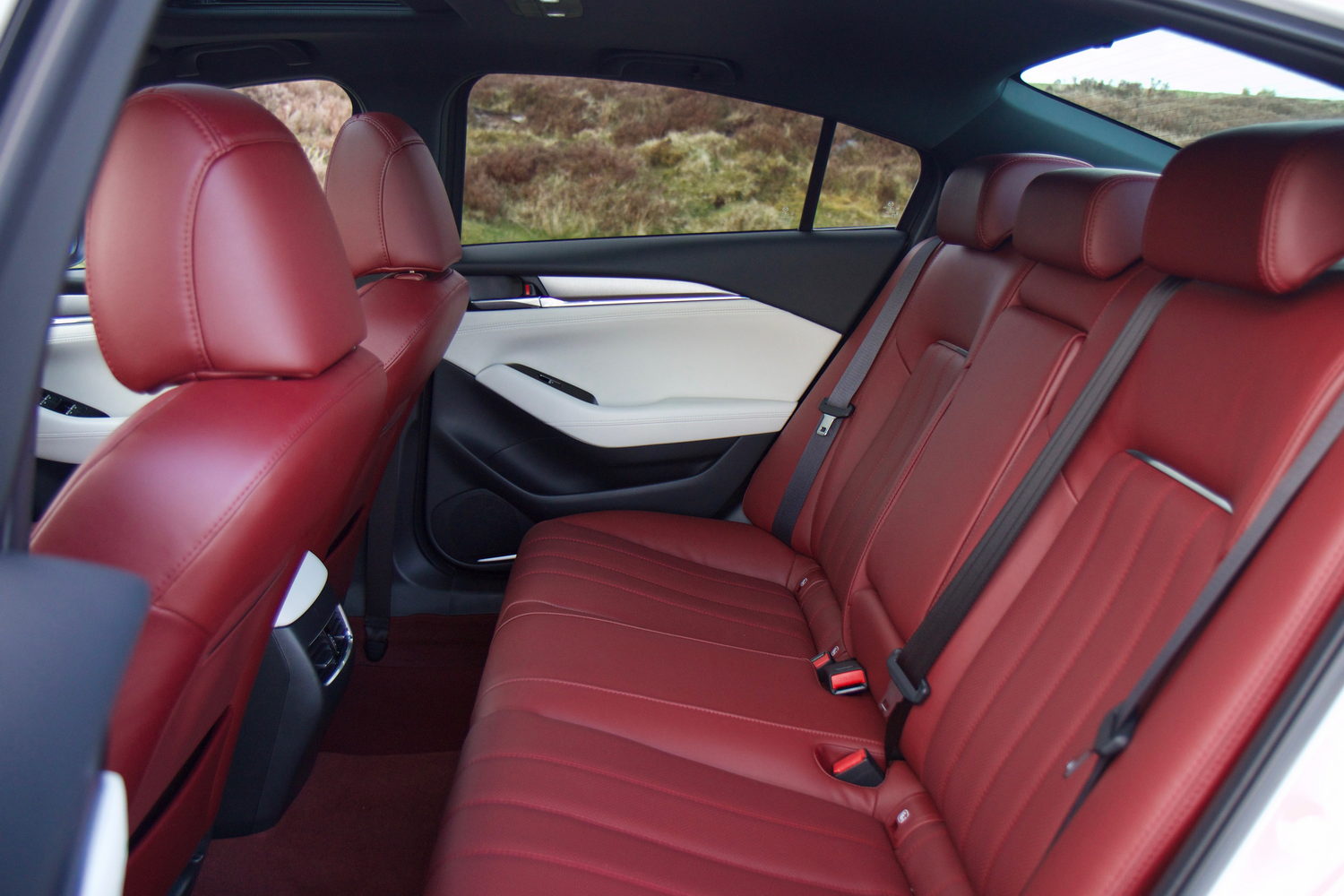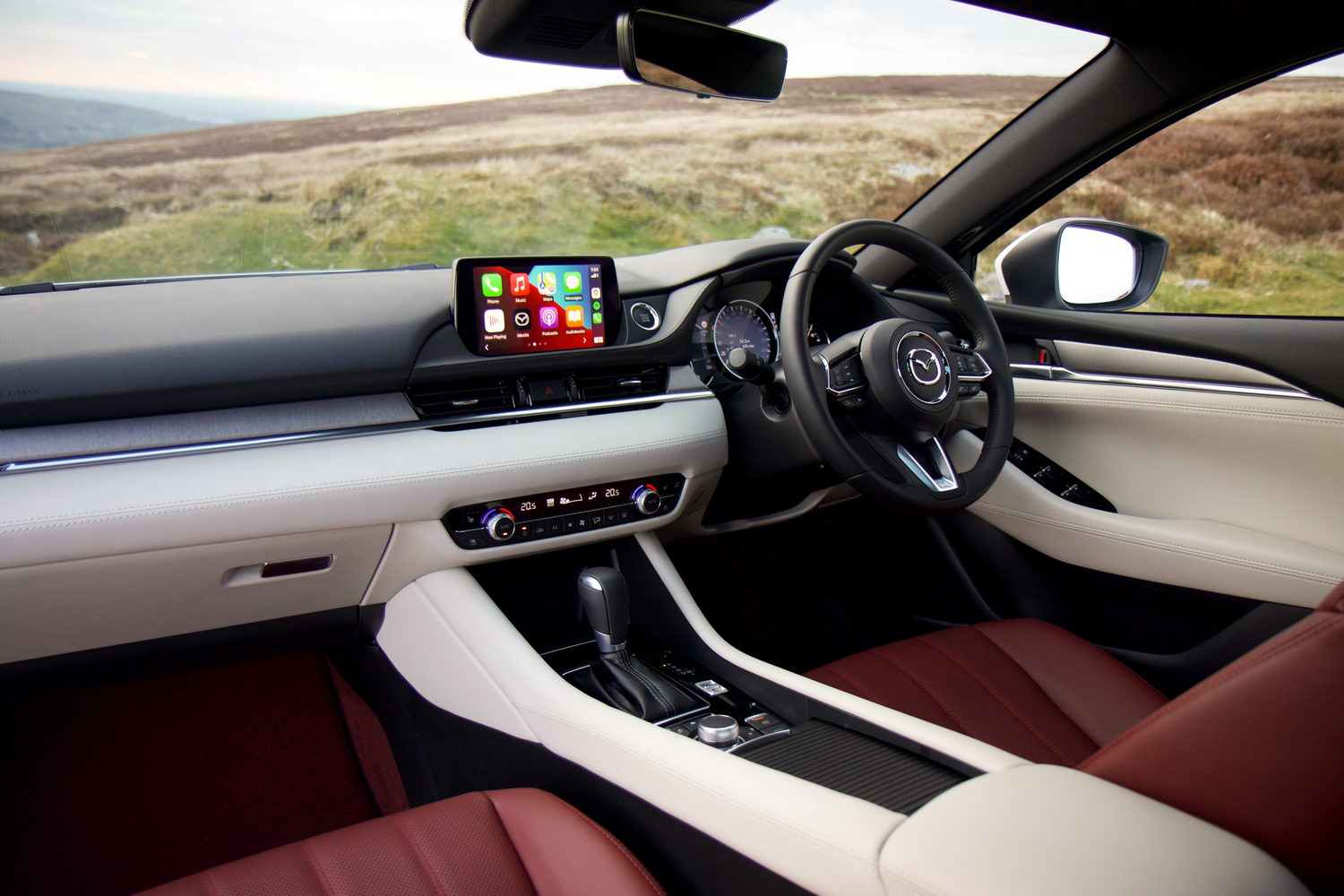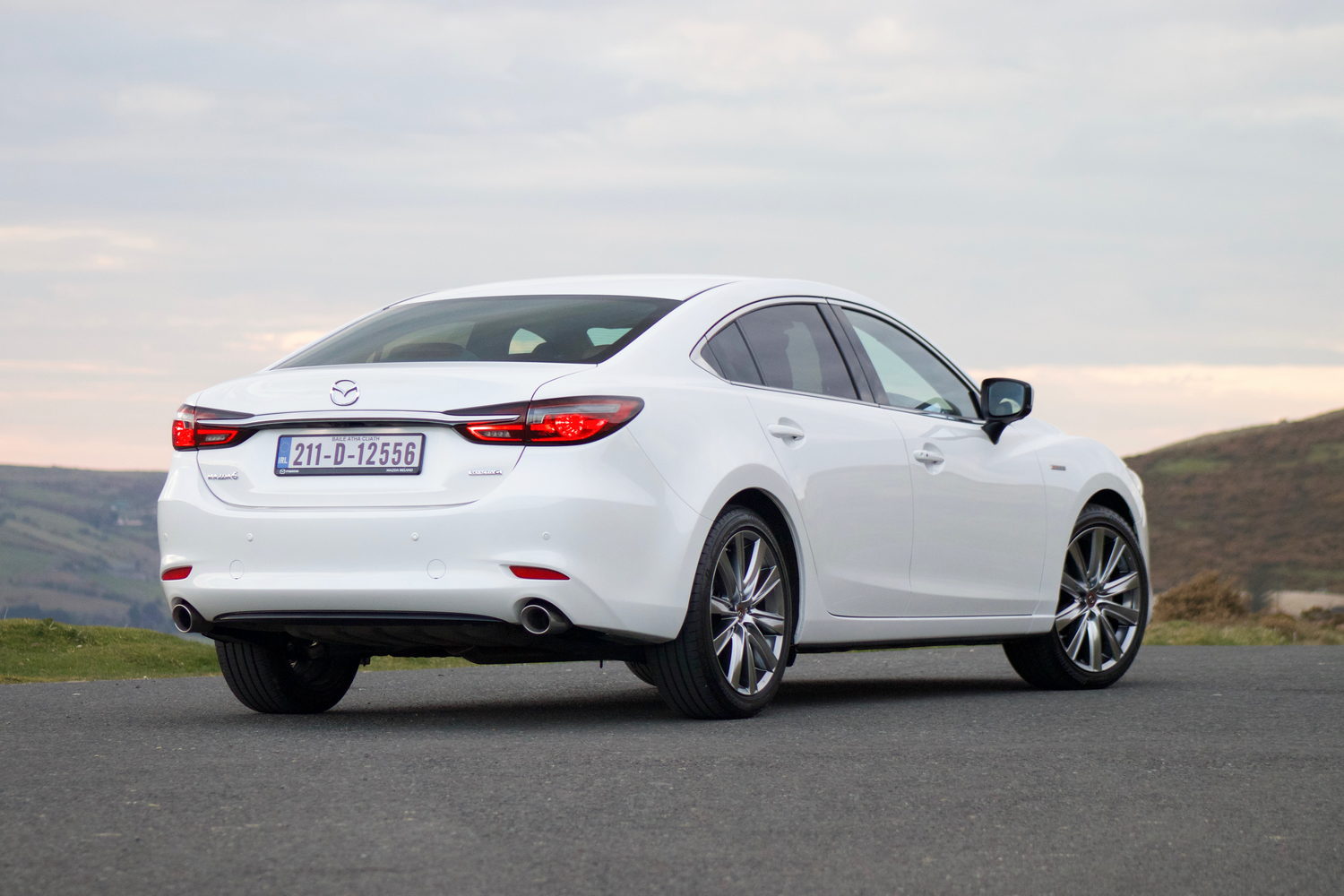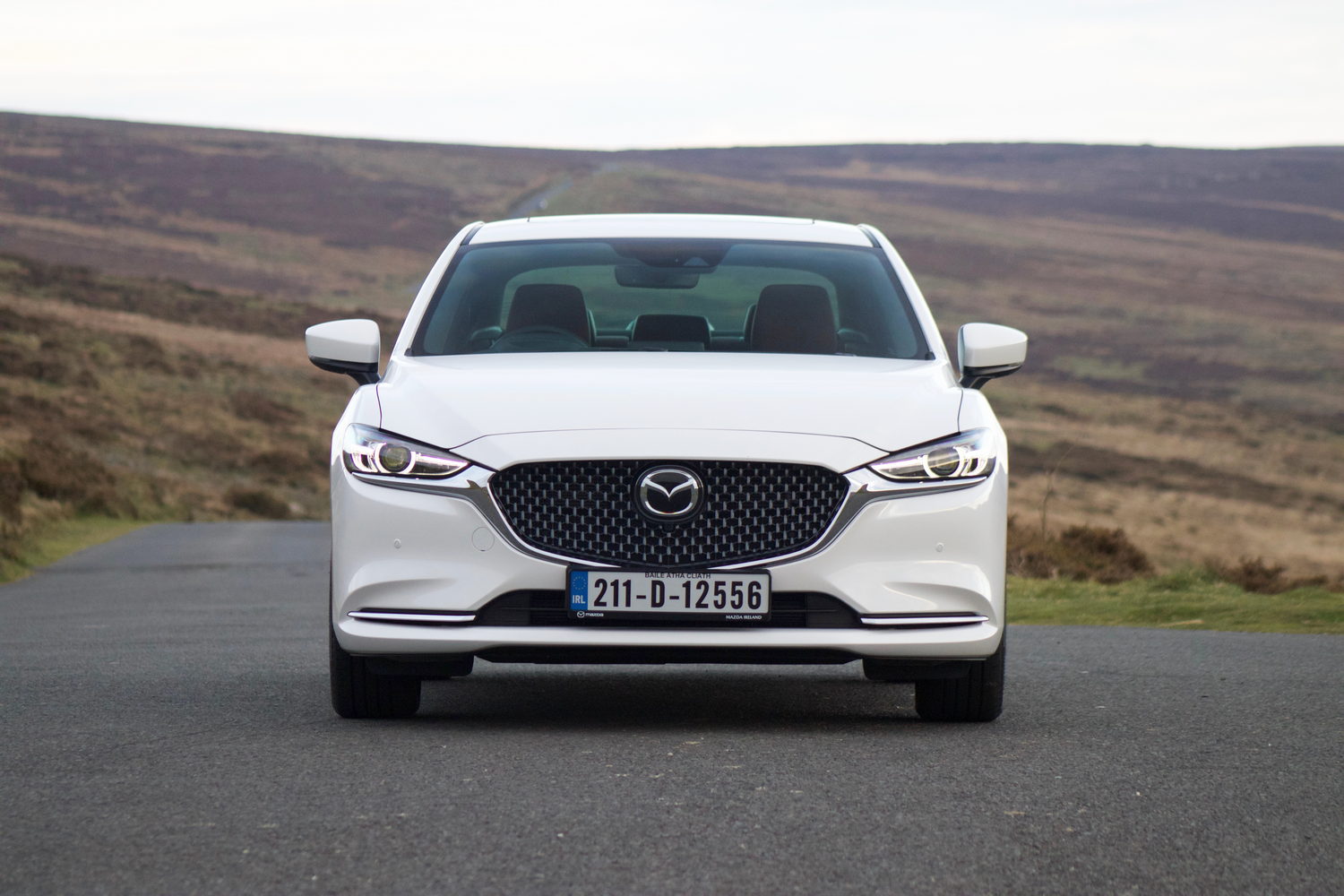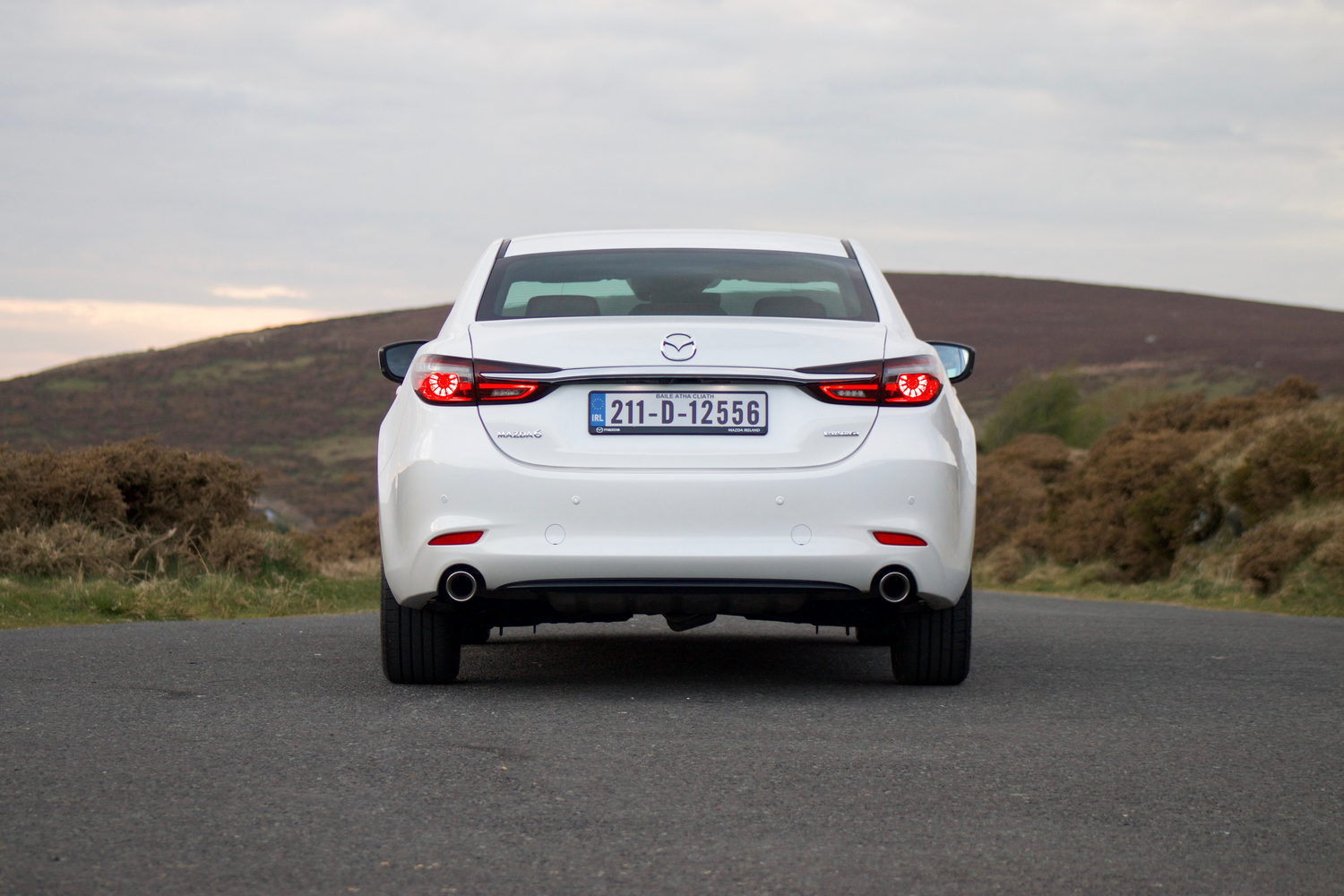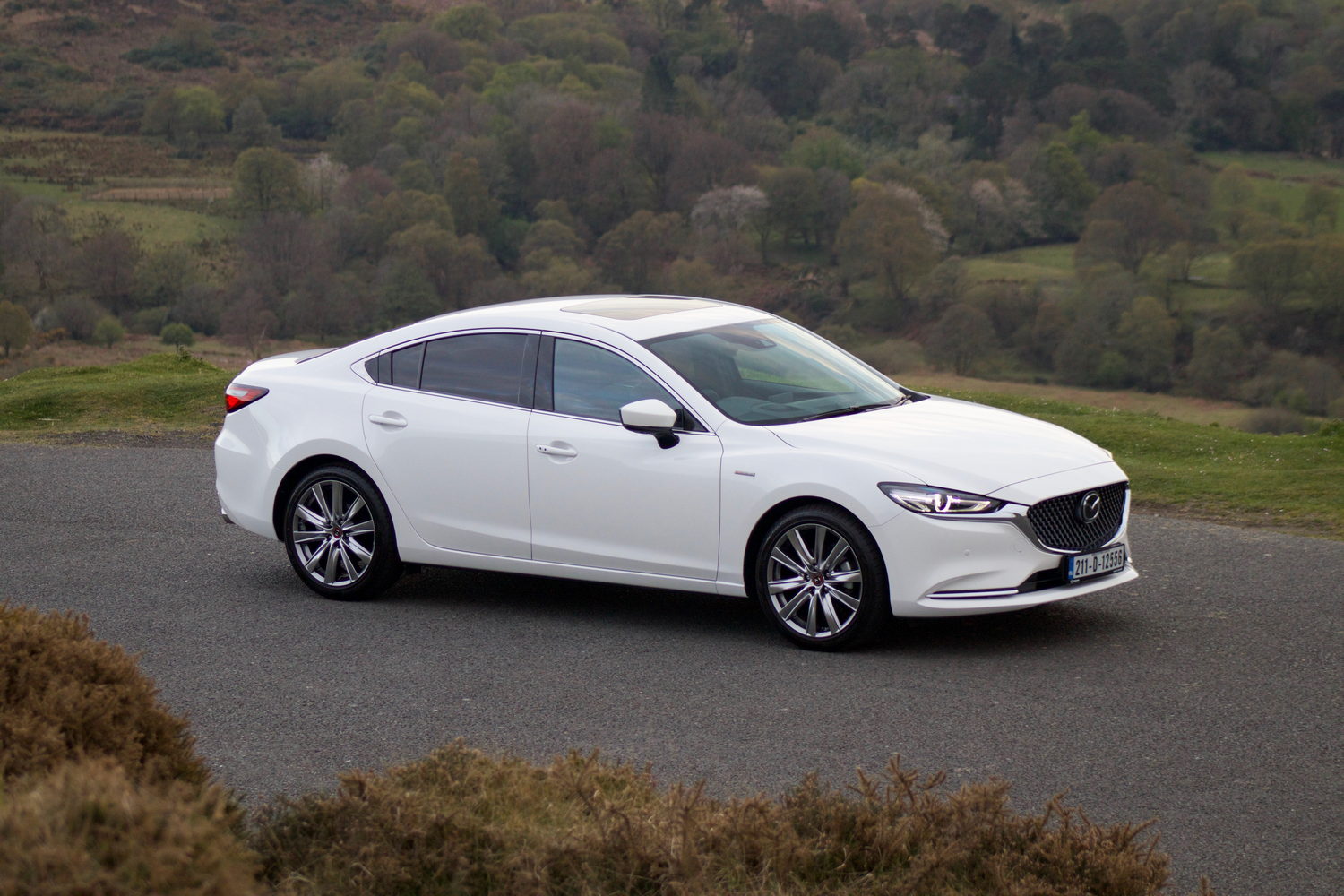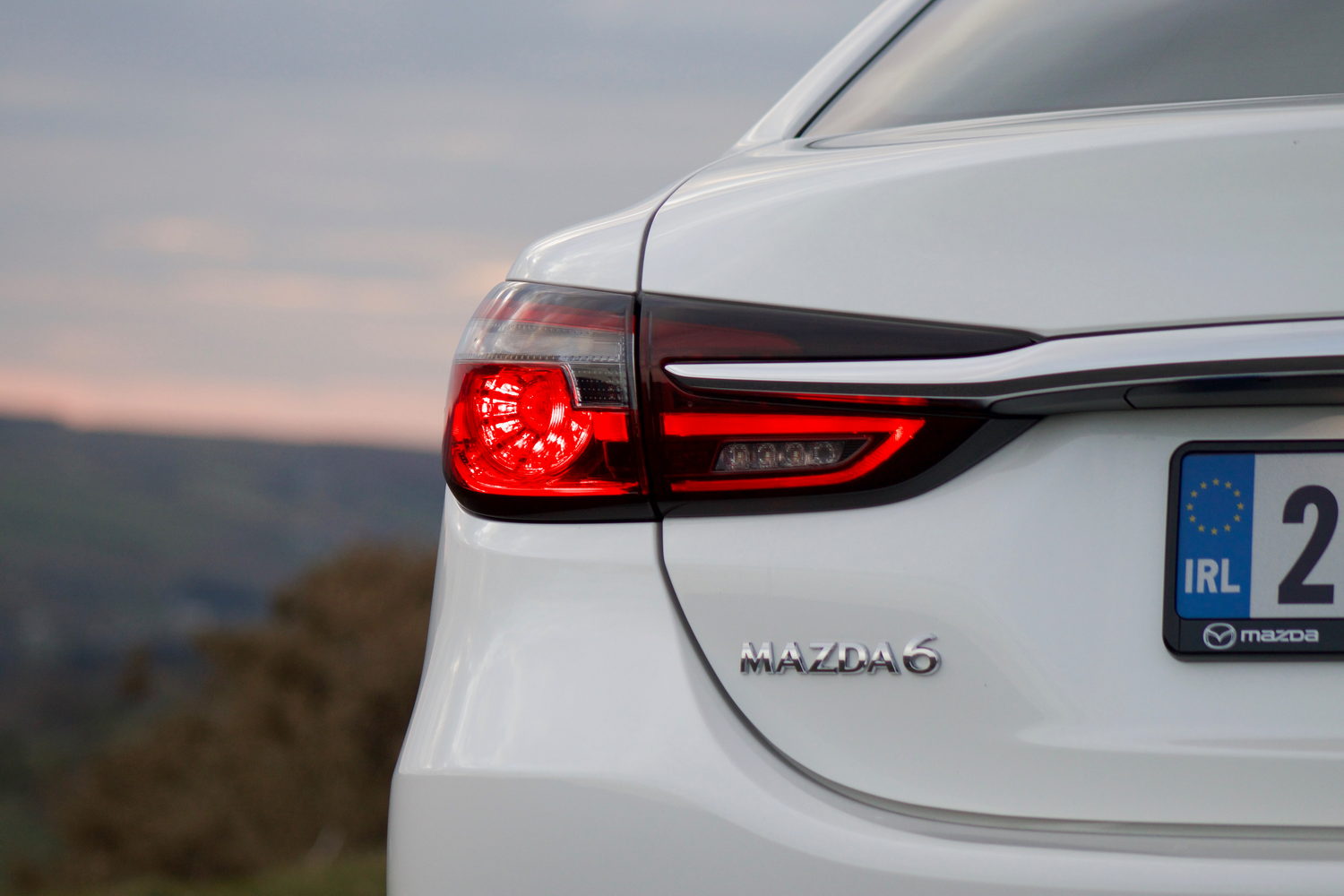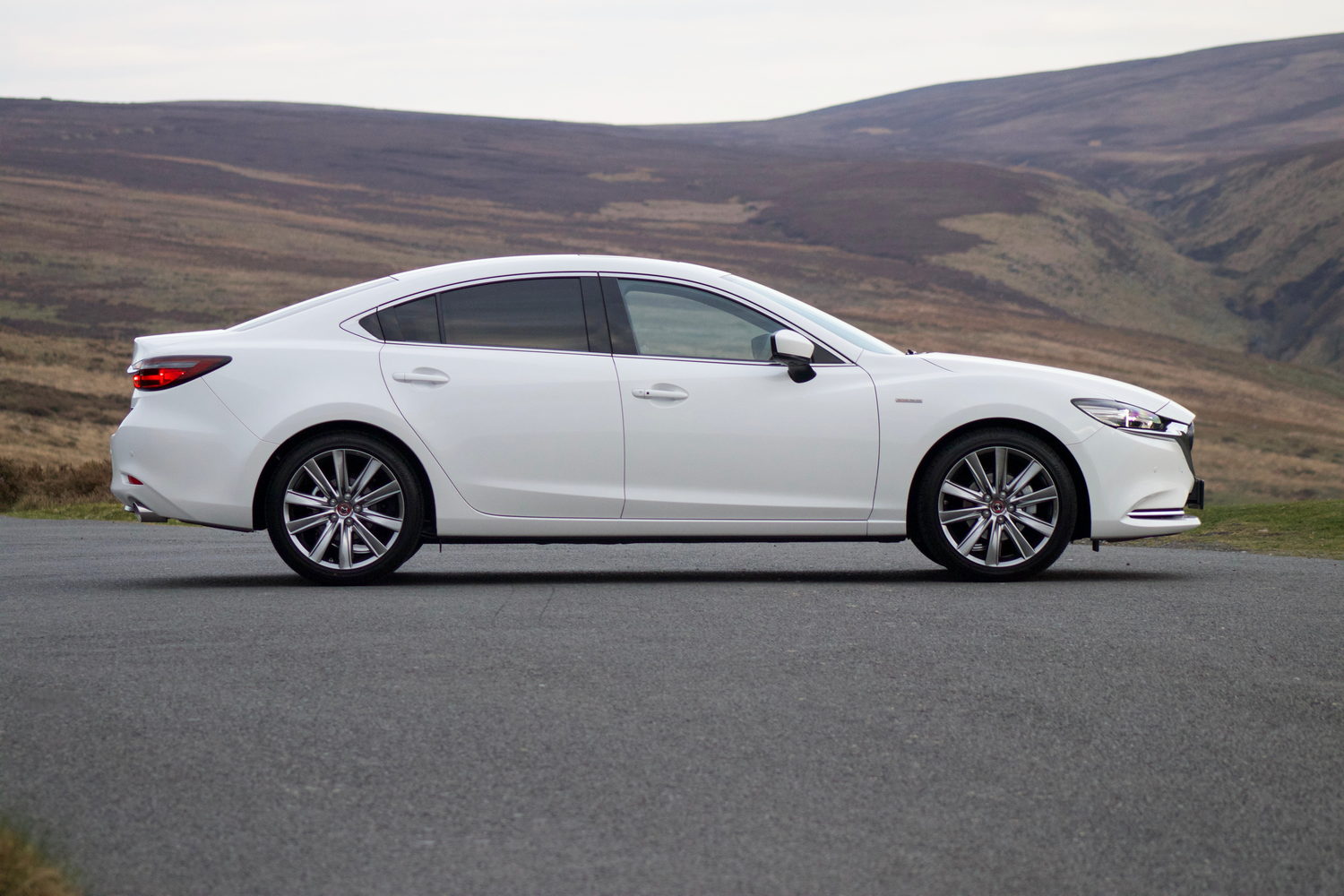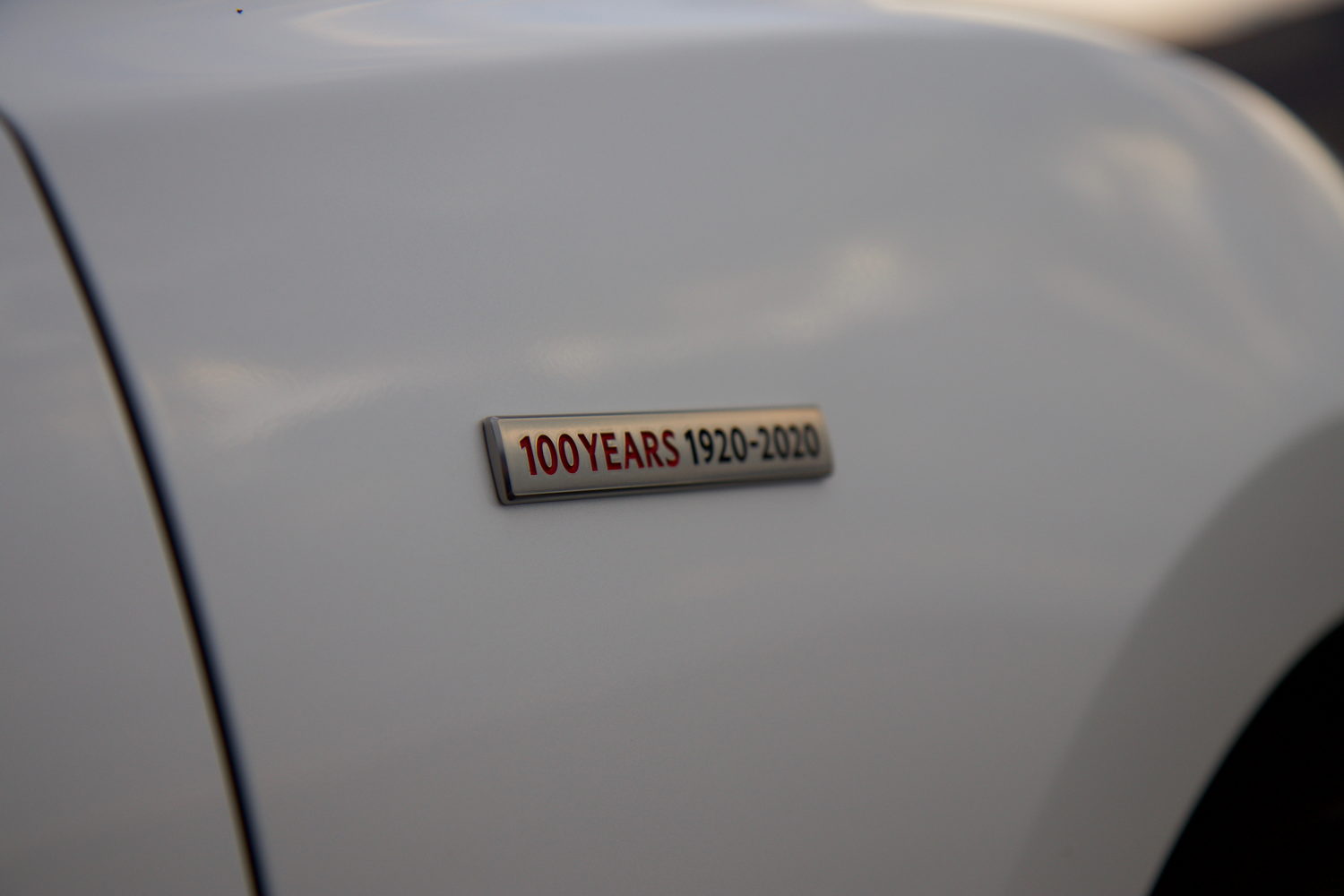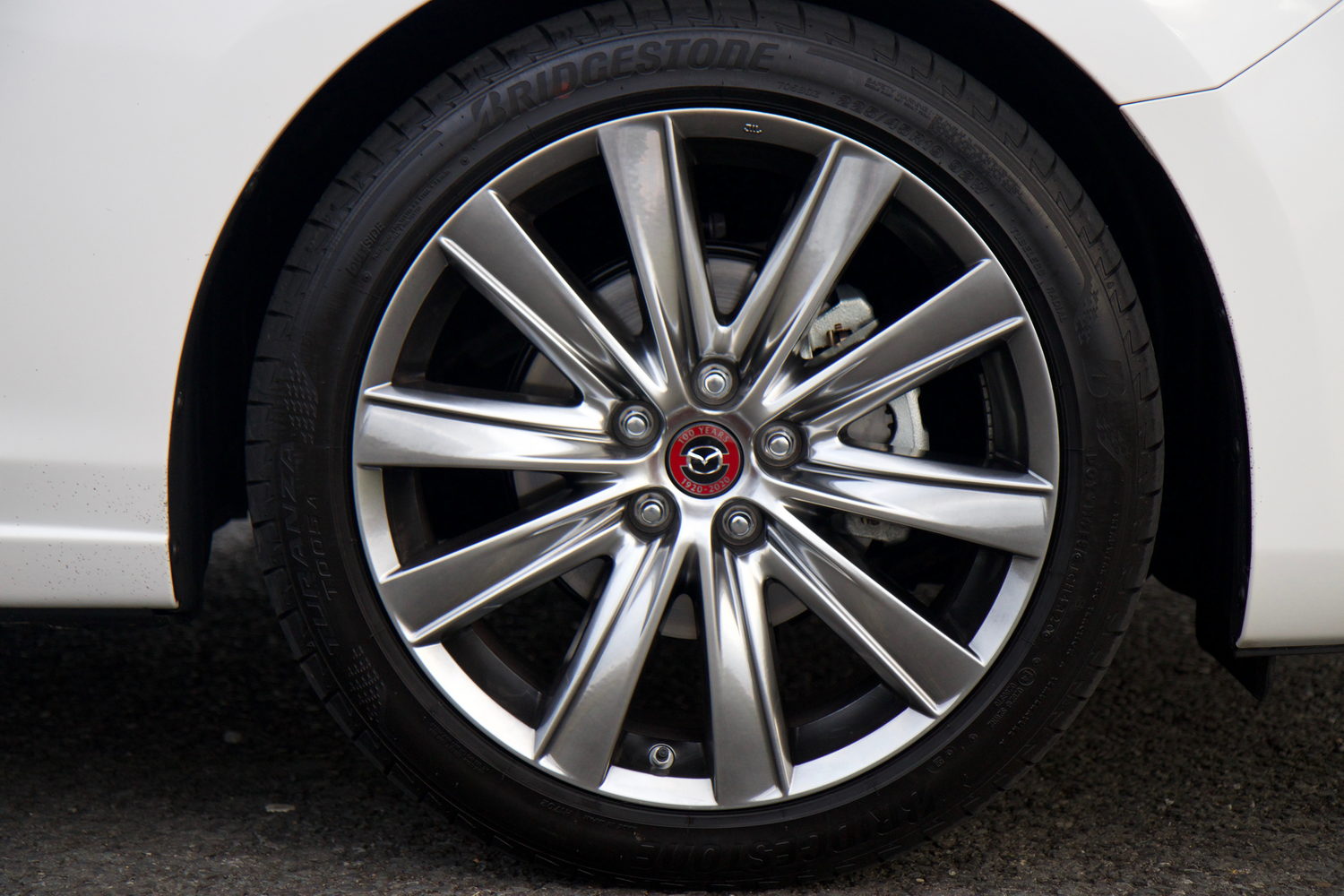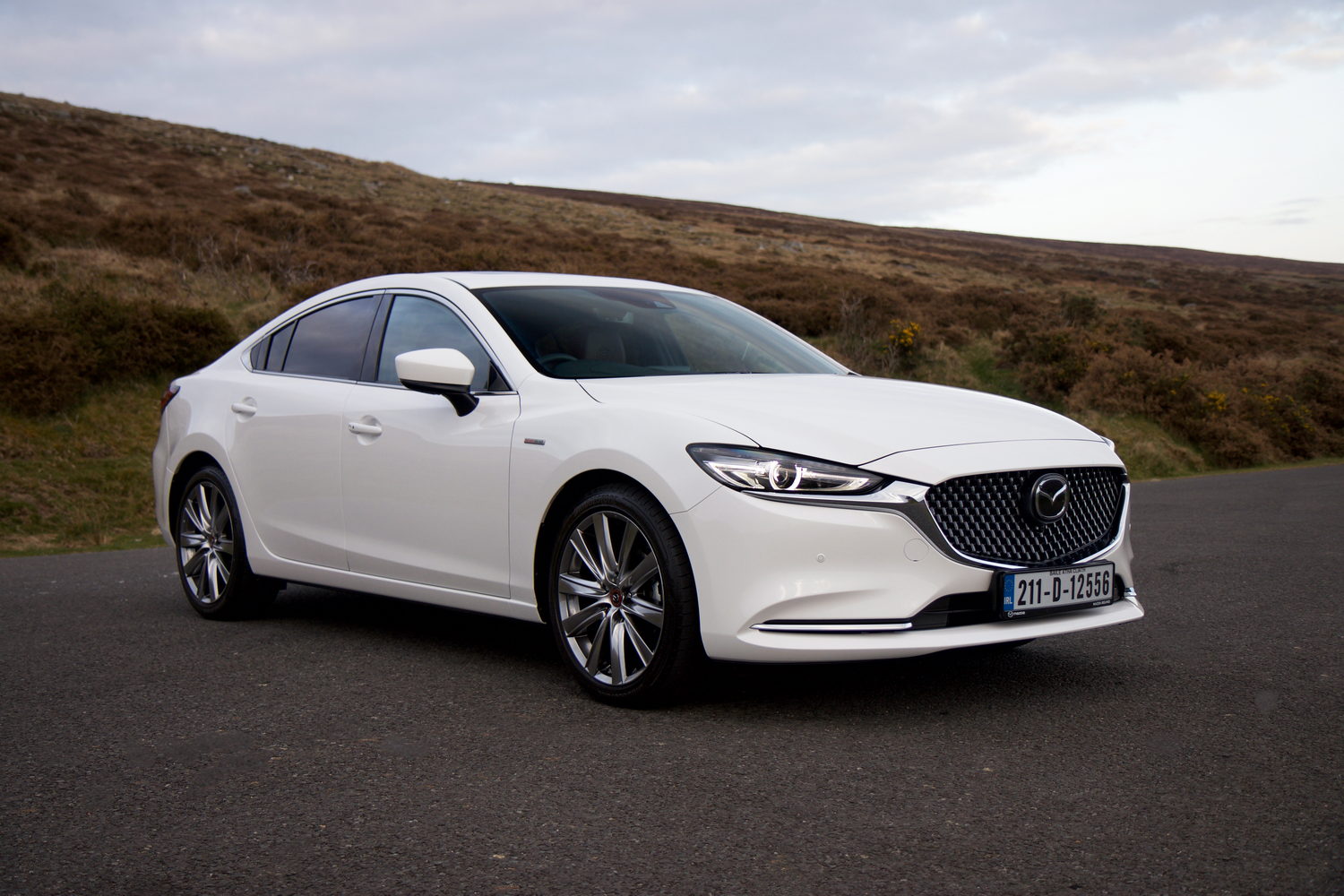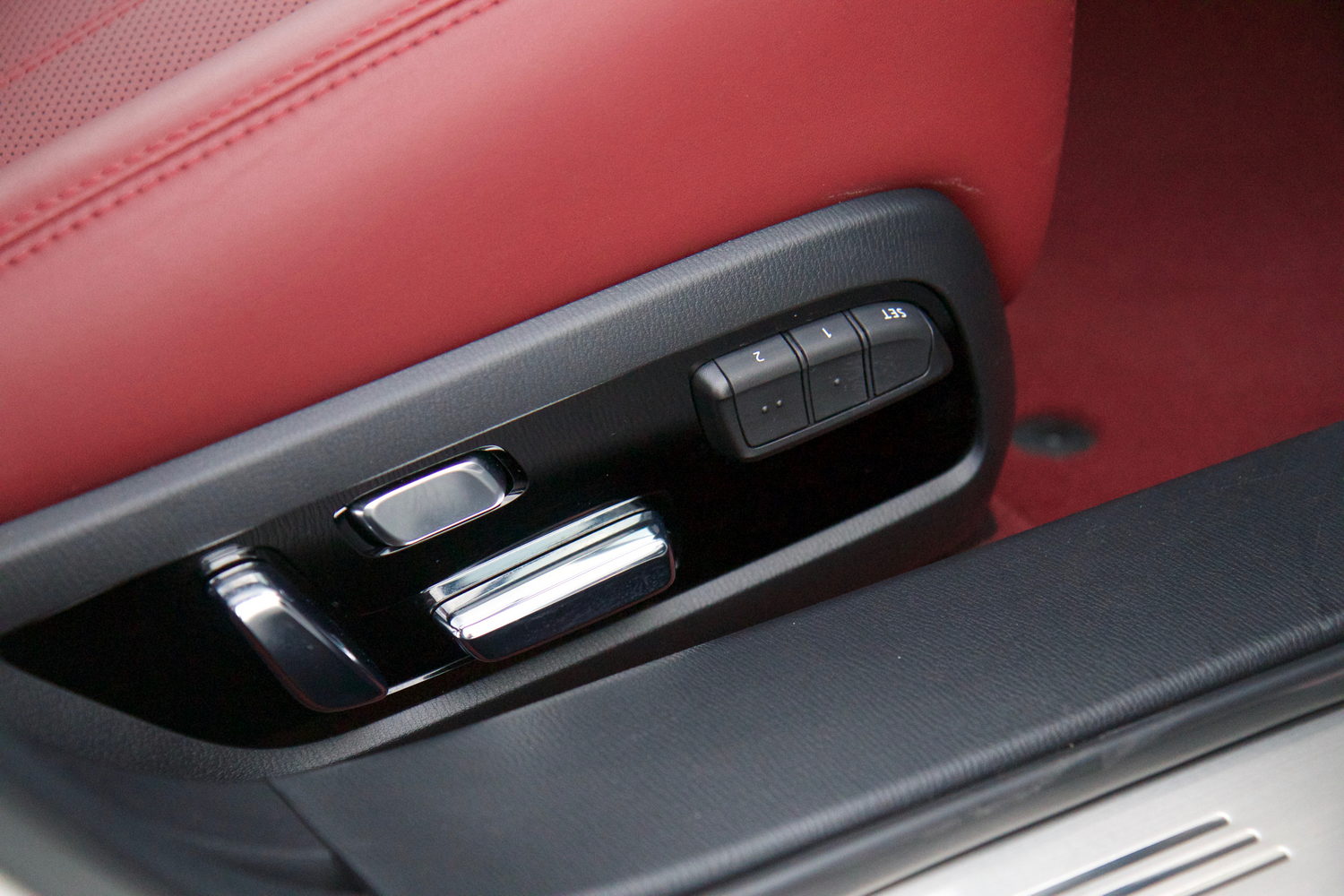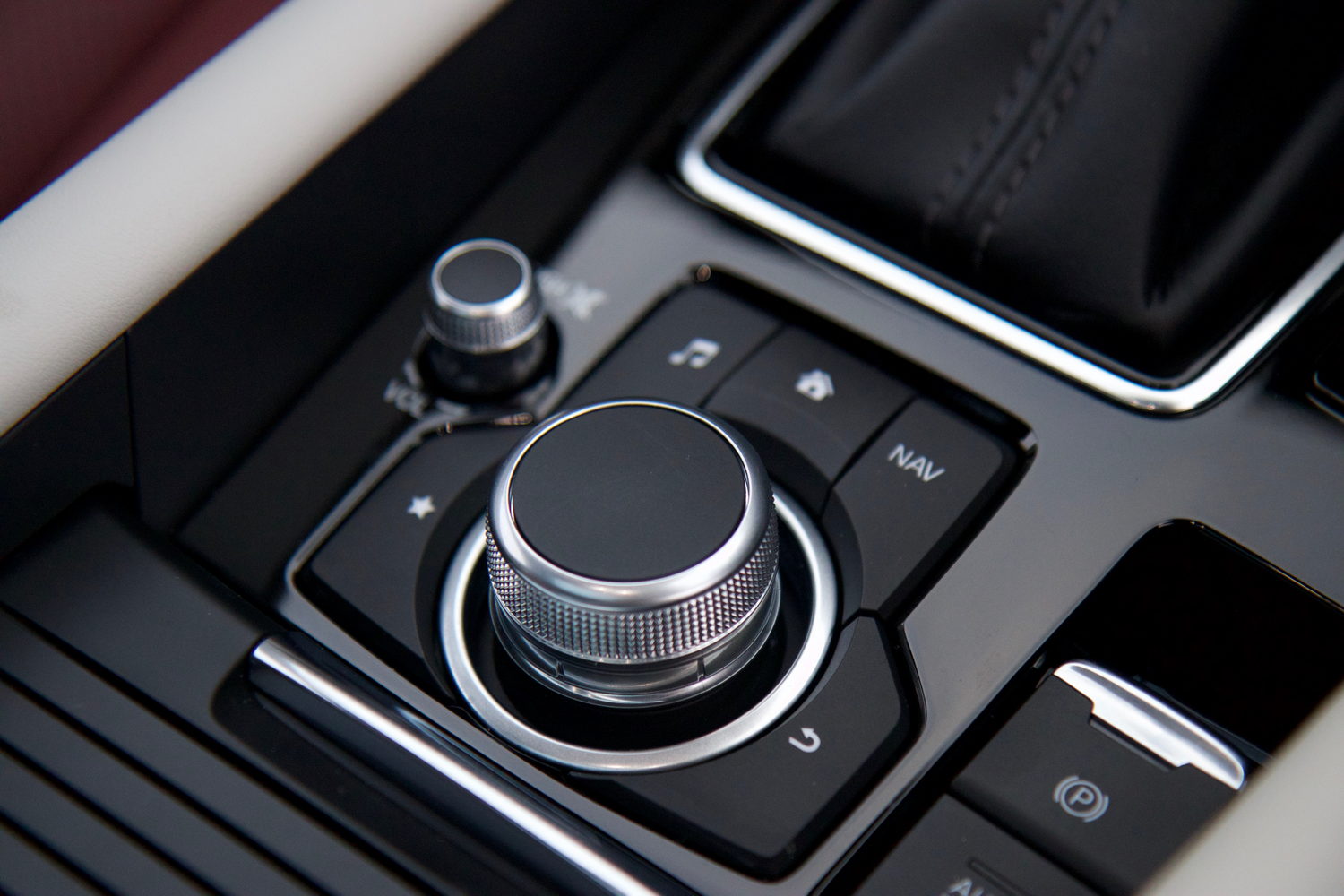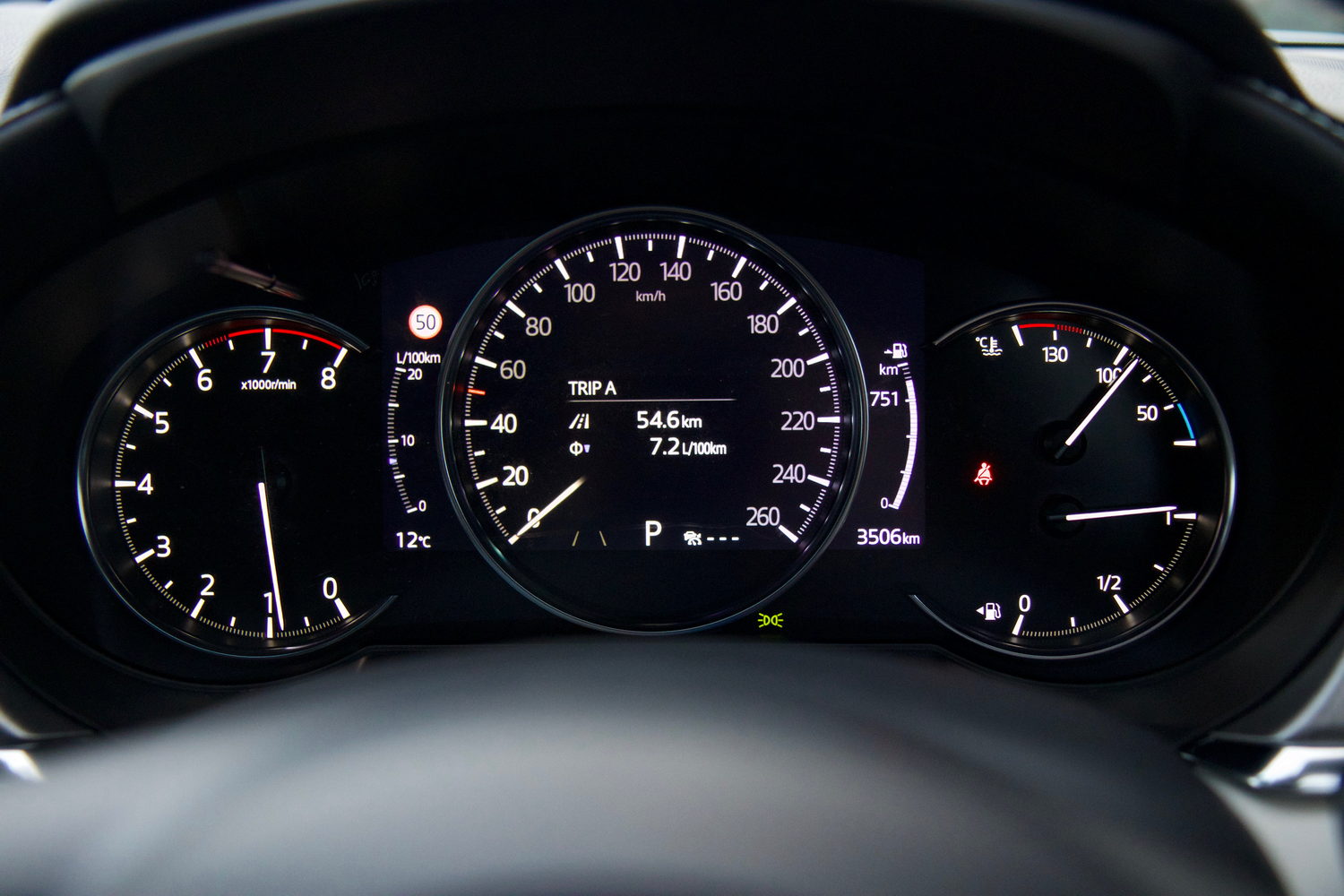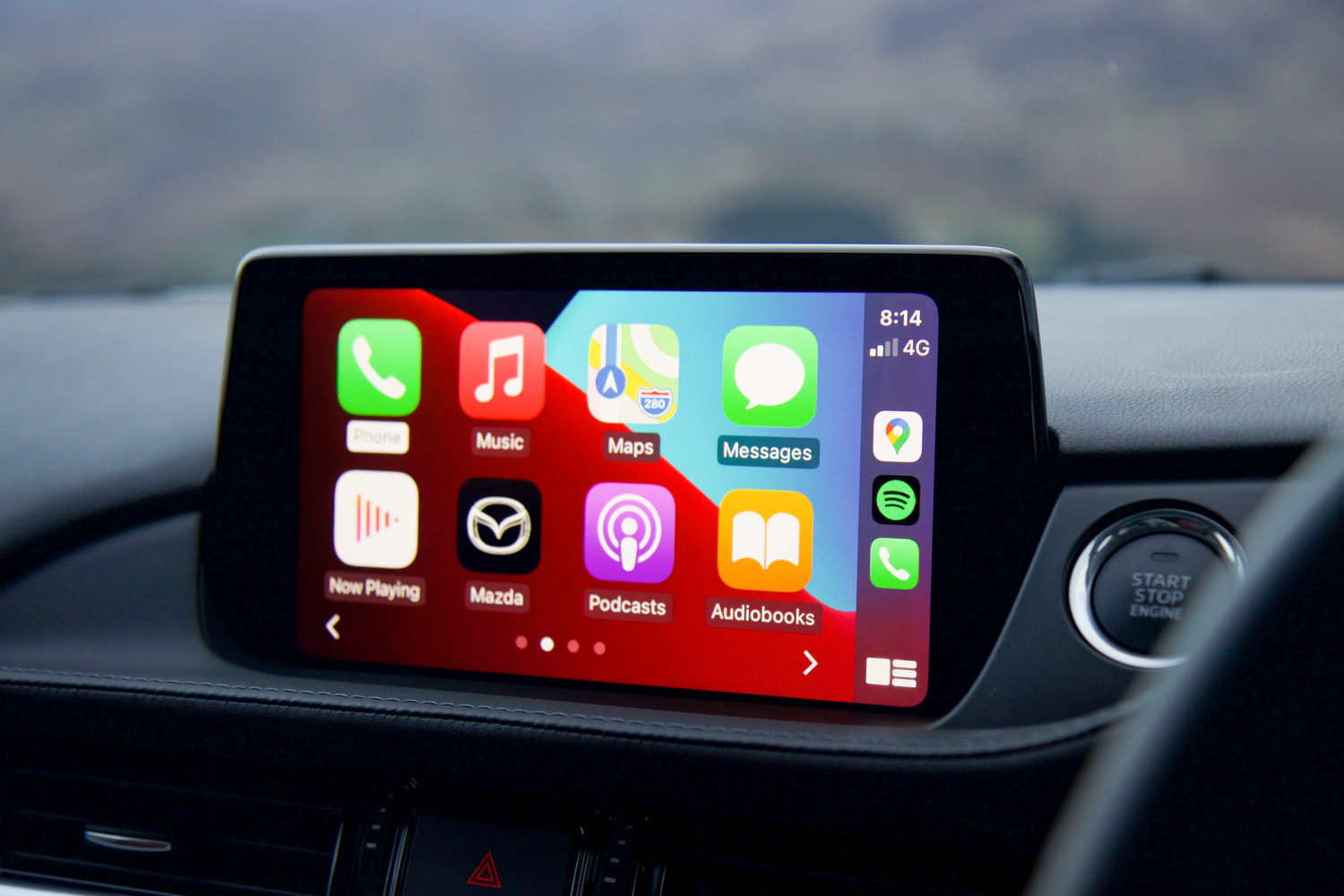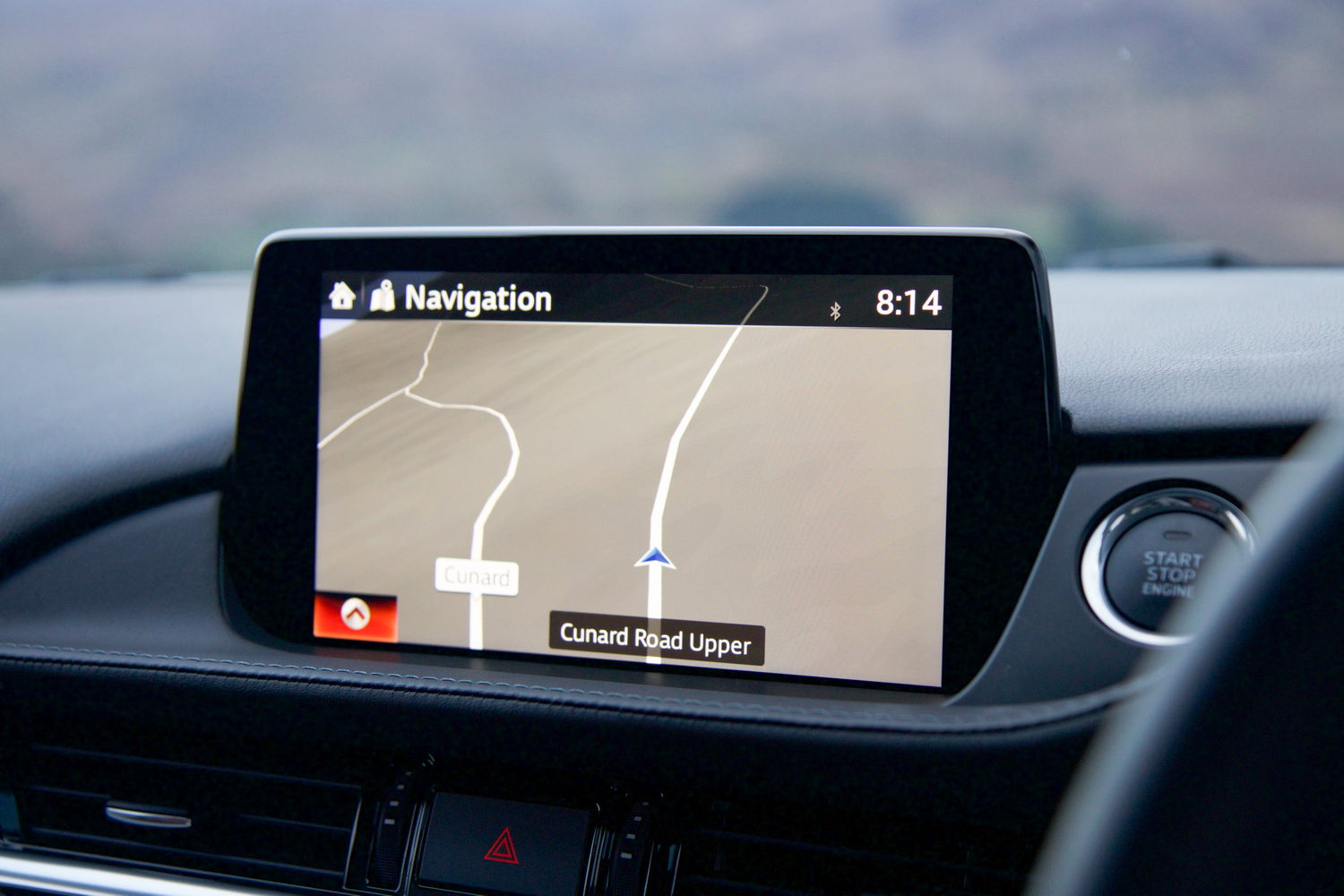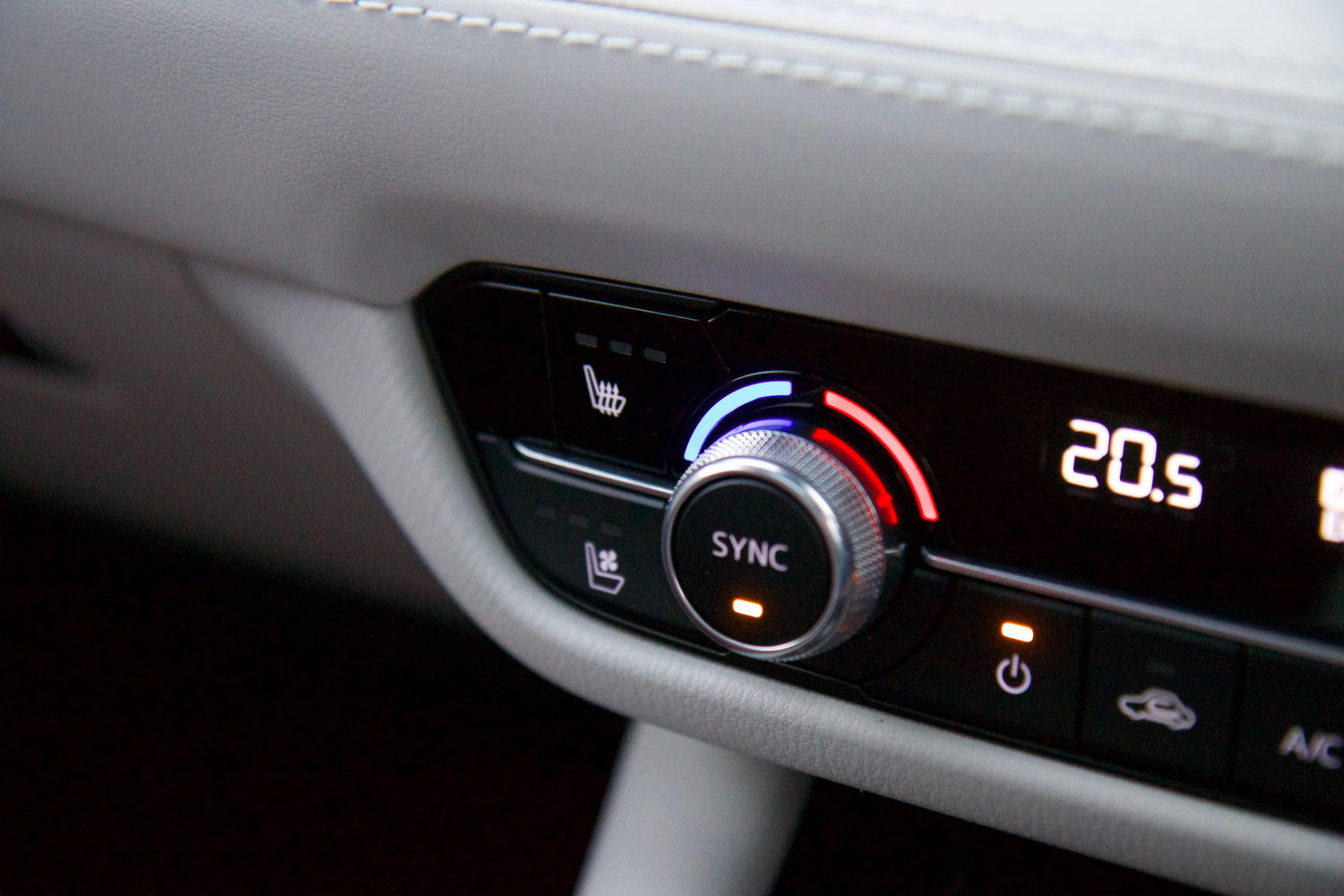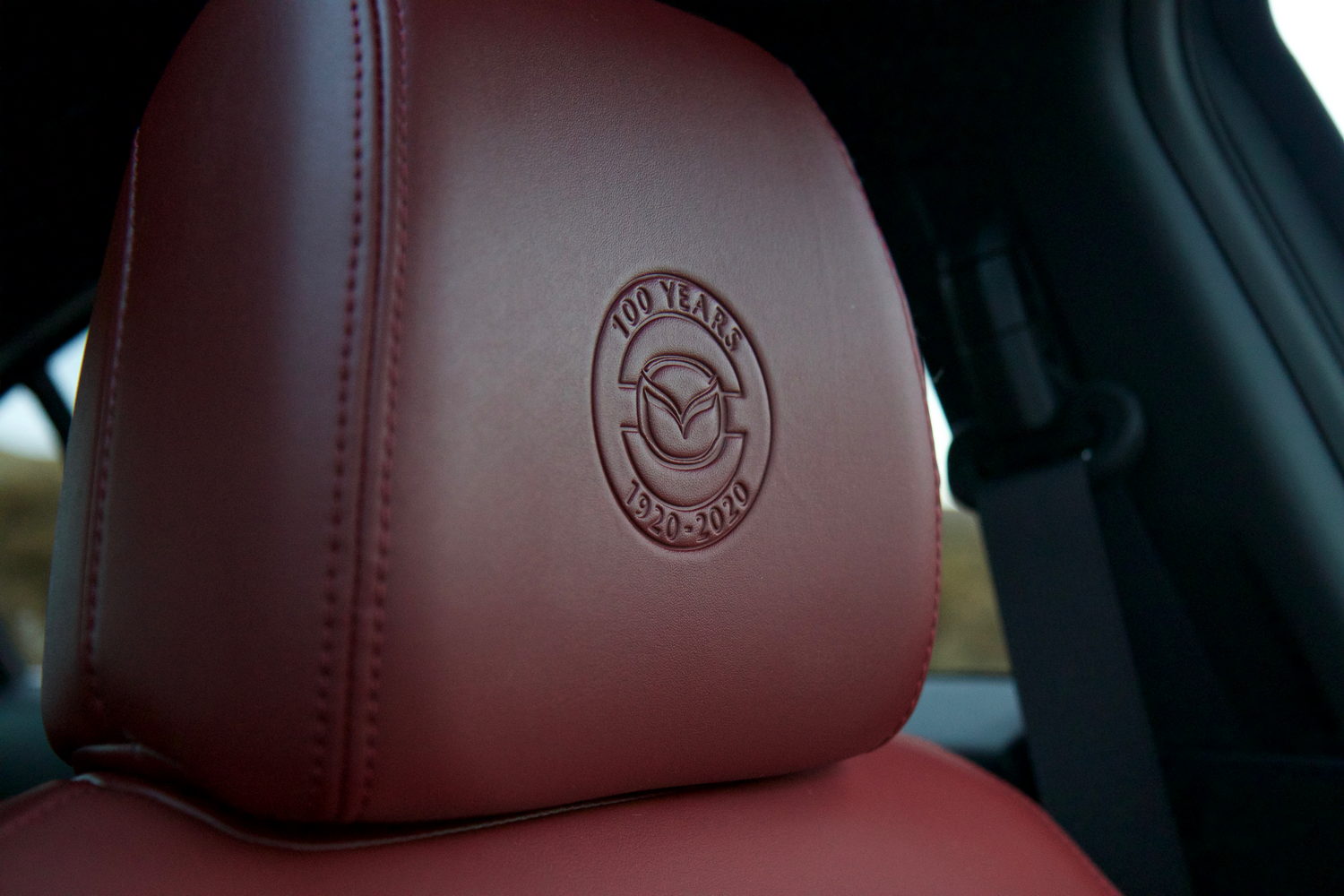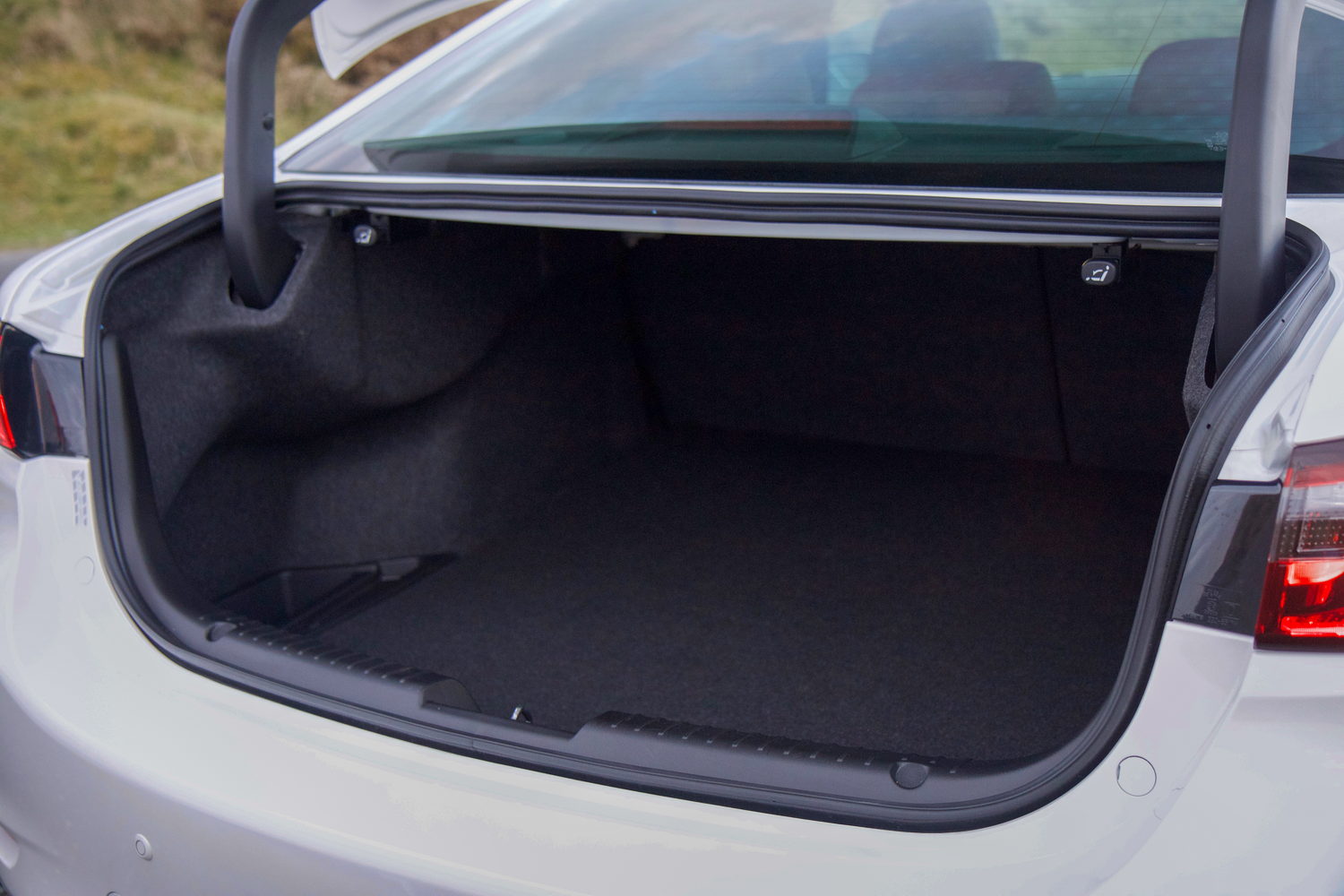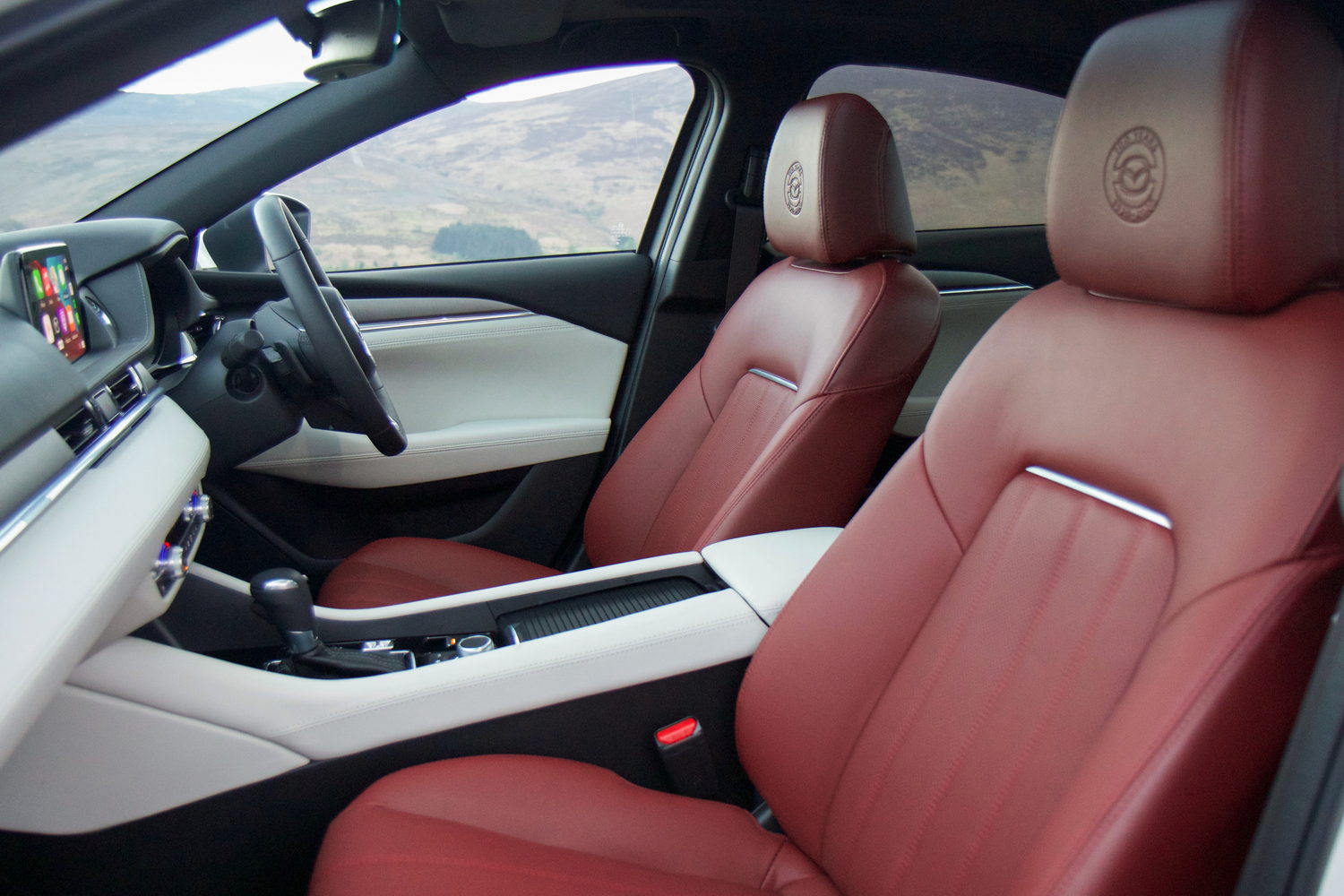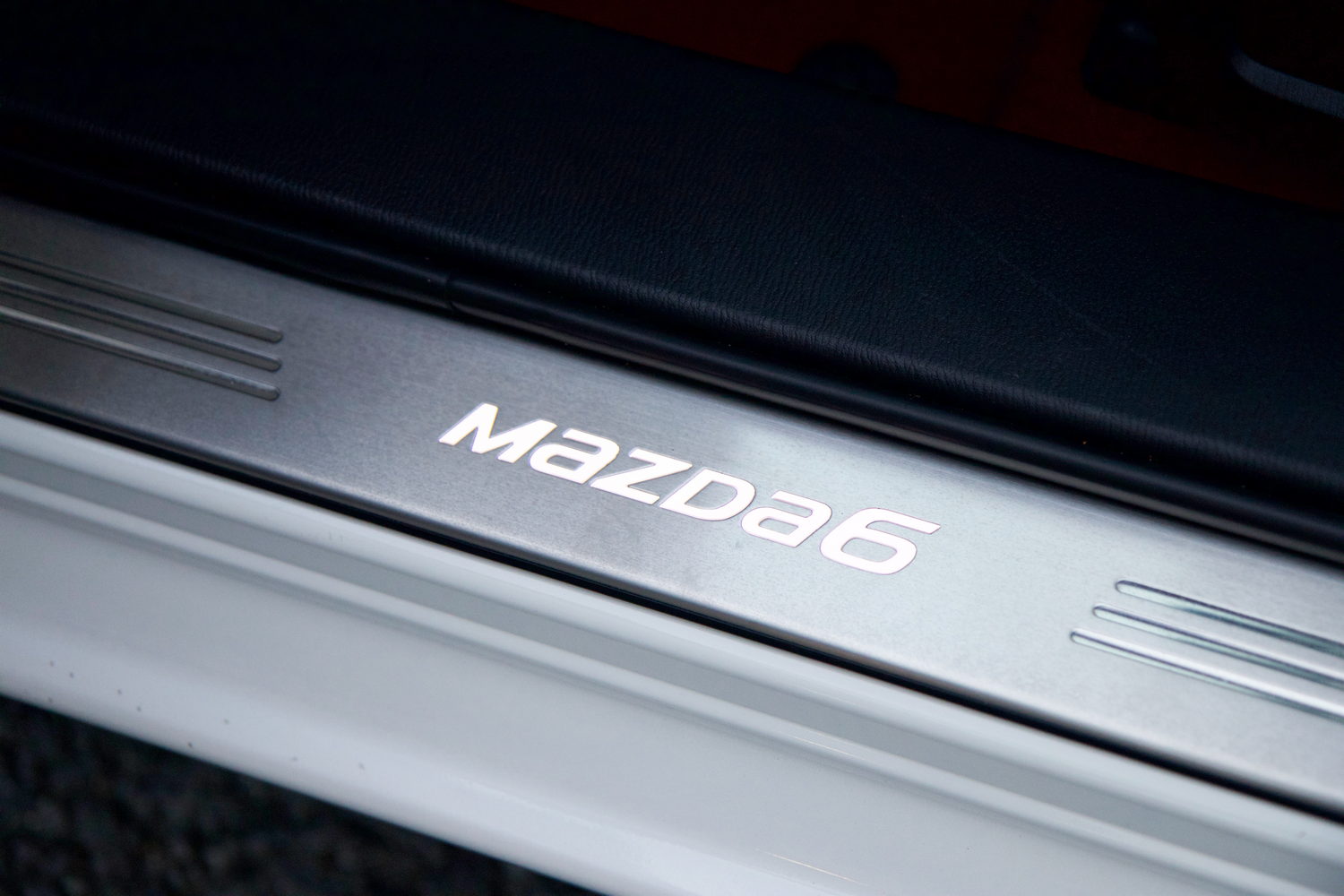Mazda6 overview
For something that has been around for as long as the Mazda6, it's still a very good-looking car. Mazda's Porsche-esque policy of continuous year-on-year minor improvements has somehow kept a car that first went on sale in 2013 looking fresh and handsome. At least on the surface.
That policy has also seen the Mazda6 adopt new engines and a great deal of extra under-the-skin technology since it was first introduced, but that increasingly feels like King Canute trying to hold back an inevitable tide. The paying public, sadly, wants more and more SUVs, and while the four-door (and optional estate) Mazda6 still has direct rivals in the shape of the Peugeot 508, Ford Mondeo, Volkswagen Passat and Skoda Superb, the simple fact is it's not them it's really fighting. The 6's greatest challenges now are age and SUVs.
So, Mazda has given it yet another small refresh. The grille has been subtly altered once again, and there's a new engine. Well, new to us - this 2.5-litre four-cylinder naturally aspirated petrol unit, called the 'SkyActiv-G', has been around in the US and UK since 2018, but this is our first chance to try it out in Ireland. It comes only with a six-speed manual gearbox, and here we're evaluating it in max-spec 100th Anniversary form.
The question is, can this Mazda6, or any 6 for that matter, still compete in a world that has, frankly, already moved on?
The Mazda6 model range
The Mazda6 kicks off with a GS-L model in four-door saloon form with a 145hp version of the 2.0-litre, four-cylinder SkyActiv-G engine (the G is for 'gasoline' - there are no diesel engines in the Mazda6 line-up anymore). Prices for this model start from €34,170 with CO2 emissions from 152g/km.
For €37,095, you can upgrade that same model to a six-speed automatic version, which to be honest seems like a lot of extra money for a gearbox that, compared to most rivals', is missing at least one, even two, cogs. However, while it's a touch expensive on the sticker, the 6 pulls Mazda's usual trick of having plenty of standard equipment. Highlights for the basic GS-L include LED headlights with auto high beam, a head-up display, 17-inch alloy wheels, leather trim for the steering wheel and gear shifter, an eight-inch central infotainment screen with Android Auto and wireless Apple CarPlay, two USB connectors, radar guided cruise control and automated emergency braking, speed sign recognition, blind spot monitoring, lane-keeping steering, navigation, auto dimming mirrors, auto wipers, two-zone climate control and front and rear parking sensors.
Next up the spec sheet is the Homura model, which starts at €40,170 and powered by the 165hp version of the 2.0-litre SkyActiv-G engine. That comes with 19-inch alloys, black exterior finishers, adaptive headlights, an upgraded grille with a more '3D' look to it, Nappa leather seats finished in a fetching shade of deep red (brown or pale beige are also available), power adjustment for the heated front seats, an 11-speaker Bose stereo, keyless entry, a de-icing heated strip for the front wipers and a rear-view camera. You can also specify a 'Safety Pack' that adds items such as rear-facing emergency brake support, driver attention alert and a 360-degree parking camera, all of which bumps the price up to €40,770.
Next up is the Platinum Lux model, which comes with the same 2.5-litre SkyActiv-G engine as our test car. Prices for this model, with CO2 emissions of 167g/km, start from €46,495, and you get the six-speed automatic gearbox as standard. Other standard equipment includes adaptive LED headlights, the rear-facing emergency brake support, driver attention alert and a 360-degree parking camera from the Homura Safety model, along with a sunroof, a radiator grille finished in gunmetal grey, brown Nappa leather seats, LED interior lights, part-digital instruments, heated rear seats, black roof liner, wood trim (and it's real wood, too), ventilated front seats and contrast stitching for the various bits of leather trim.
Finally, there's our top-spec test car - the 100th Anniversary edition. Technically, Mazda's 100th anniversary was in 2020, but we just weren't in the mood for celebrating much then. For your €47,695 you get red leather seats with embossed Mazda logos and matching carpets and floor mats, special 100th anniversary badging, including on the key fob and 'Snowflake' white pearlescent paint. Plus, anyone buying a 100th Anniversary car gets a 1:42-scale miniature model of their car, and a coffee-table book detailing the history of the brand. Nice, but not worth the extra money over the well-equipped Homura model.
There's one other Mazda6, and that's the very handsome (and practical) estate model, which these days comes in just the one trim level (buyers in Ireland are even less keen on estates than on saloons, which is our loss frankly - a 6 estate makes a much better family car than any SUV you care to mention), which is the basic GS-L grade, with CO2 emissions of 155g/km and a price tag of €35,770.
At the time of writing, Mazda has a PCP finance offer for the 6, starting from €361 per month, with a €2,000 contribution and 5.9 per cent APR interest. Check out the Mazda Ireland website for up-to-date finance offers.
The Mazda6 100th Anniversary interior
The Mazda6 100th Anniversary's interior is at once both its best and worst feature. If the definition of intelligence is being able to hold two conflicting ideas in your head without going mad, then the Mazda6's cabin is working at the doctorate level.
What's good? Well, the quality levels are absolutely sensational. It's true that some of the padded leather surfaces maybe feel a little over-stuffed, compared to the sleeker, slimmer surfaces of German rivals, but the way the Mazda6's insides are put together is just lovely, and hugely confidence-inspiring. Obviously, Mazda has a reputation for reliability and longevity, and that reputation is made solid and tangible in the way this cabin is assembled.
It's wonderfully comfortable too, with good front seats and a highly adjustable driving position (although the motors for the powered front seats are noisy). Space in the back is fine, if not exceptional, but there's enough room back there for all but the longest legs and tallest heads.
Precisely how you will feel about this particular Mazda6's interior will depend on how you feel about dark red leather seats and matching carpets (with contrasting white leather elsewhere). I like it - it reminds me of the decadent interiors of mid-sixties Jaguars, but I'd totally understand if you didn't get on with it. It's either like sitting in an expensive handbag (if you're feeling charitable), or inside a blood clot (if you're not).
Given the Mazda6's age, it's hardly a surprise to note that its infotainment and switchgear layout is equally aged. There's good and bad in that - the infotainment system is Mazda's older one (not the slick newer system as fitted to the Mazda3 and CX-30) and is really unimpressive these days, with clunky graphics and a less-than-intuitive menu system. It's controlled by a neat rotary switch on the centre console though, which still feels safer to use when you're driving than stabbing at a touchscreen.
The heating, ventilation and air conditioning control panel looks a bit old-school, but that's fine by us - the big buttons and rotary controls are really simple and easy to use, and put the fiddly touchscreen setups of some rivals to shame. Higher up, the main instruments use a mixture of a digital screen with analogue dials. The analogue dials are lovely, with clear, delicate markings, but the digital bit is a let-down, with little in the way of customisation.
Down on the centre console, there's a large storage tray in front of the gear shifter, which is where you'll find the optional wireless phone charger. Behind and beside the gear shifter are the click-wheel for the infotainment system, and the electronic parking brake switch. Behind those is a storage area with a sliding cover that houses two large cupholders.
Behind that, and under the armrest, is a deep storage area with two USB-A ports, a 12-volt socket and an aux-in socket if you're feeling a bit old-school about how you connect your media player. There are more USB sockets in the back seats, under a flap in the rear fold-down armrest. The Bose stereo is predictably fantastic, incidentally.
Out the back, the Mazda6's boot is a little disappointing. With just 480 litres of luggage space, it's well behind what you get in the likes of a Passat or, especially, a Skoda Superb. The rear seats do fold flat, and completely flat at that, but if it's a properly practical Mazda6 you want, then you need to go for the estate with its 522-litre boot.
The 6 has three ISOFIX anchor points; two in the rear outer seats, and one in the front passenger seat.
The Mazda6 100th Anniversary driving experience
Given that the 2.5-litre SkyActiv-G is the biggest capacity, and most powerful, engine ever fitted to the current Mazda6, you'd expect it to dominate proceedings. But it doesn't. A previous, brief, exposure to this engine on a short drive in the UK had us convinced that it was smooth, but in Irish conditions, and on more familiar roads, it's not so refined.
Overall, it's pretty quiet, but firm, prolonged prods of the accelerator reveal a slightly hard-edged noise as the revs rise, which is not so pleasant. The limited ratio spread - and slow changes - of the six-speed automatic gearbox doesn't help here - actually, it's a shame that Mazda doesn't offer its brilliant six-speed manual gearbox with this engine. We suspect that the two would make a much happier combo.
If it's slightly less refined than we previously thought, then the benefit of this 2.5-litre SkyActiv-G engine is that it has decent performance. Note we say 'decent.' While its on-paper figures are entirely respectable, as with the smaller 2.0-litre engine, this is a powerplant that asks you to relearn your driving style, especially if you've become used to the instant-on torque of recent turbocharged petrol and diesel engines. A glance at the torque figure tells you all you need to know - 258Nm is an entirely respectable rating, but it's developed at a lofty 4,000rpm, at least 2,000rpm higher than is necessary in key rivals with turbos. That means you have to stretch the engine to achieve decent forward progress, which wreaks its own havoc on fuel economy.
Mazda quotes 7.4 litres per 100km, but we struggled to get our own figure below 8.0 litres per 100km, and it was frequently a lot higher than that on a mixture of motorway and city driving. Driven gently, the engine's big, unstressed nature means that it certainly has the capacity to be economical, but it's a bit of a struggle to get it to perform in that arena. The consequence is a relatively high CO2 figure of 167g/km, which lands you with a €420 annual motor tax bill.
Where the 6 continues to perform strongly is in the way that it drives. It has steering weight, feel and responsiveness that honestly still put anything else in this class to shame, and it is tremendously good fun on a favourite road. The fact is that such driving is not what most people do, most of the time, so the 2.5 engine's relatively inferior performance in other areas sees the Mazda6 get marked down.
Where it gets marked up is in its ride comfort. Even on the larger 19-inch wheels of our test car, the Mazda6 has a wonderfully composed ride quality, not so soft as to wallow, but never so firm that untidy road surfaces disturb you.
Alternatives to the Mazda6 100th Anniversary
You can't yet buy the Mazda CX-5 SUV with this 2.5-litre engine, but you can have it with the really rather good 2.0-litre 165hp engine, or indeed the excellent (if unfashionable) 2.2-litre diesel, and it arguably is the 6's most important rival, matching it for looks (mostly), dynamics (almost) and quality (certainly), but exceeding it for desirability (arguably).
Skoda's Superb is the 6's most dangerous foe from a rival car maker. Skoda's reputation for reliability comes close to matching that of Mazda, and the Superb simply can't be beaten when it comes to interior space and roominess. It's not as sharp to drive as the Mazda, but its base 1.5-litre turbocharged petrol engine has better all-round performance, and vastly superior fuel economy to the Mazda's 2.5.
The Volkswagen Passat is basically the same as the Superb in a mechanical sense, but trades ultimate cabin and boot space for an arguably more desirable badge and bodywork.
Or there's Peugeot's lovely 508, a fastback saloon with coupe-like styling and frameless doors. It's more practical than you'd think at first, and if the cabin quality can't quite match that of the Mazda, then its chassis is certainly up to the task. It's available as an impressive plug-in hybrid model, too.
Our verdict on the Mazda6 100th Anniversary
Driving the Mazda6, in its current form, is a bit like watching the more recent films of Arnold Schwarzenegger. You can see the professionalism, the craft, the sheer reliability of the whole package, but you can also see that the years have taken their toll. The Mazda6 operates in what has become a deeply (and unfairly) unfashionable end of the market, and it's not helping its cause by falling prey to inevitable ageing. Mazda is working on a rear-drive replacement for this 6, with a six-cylinder mild-hybrid engine that incorporates the clever variable-compression ignition tech of the SkyActiv-X engine line-up, and we'd expect to see a fully electric variant in the future too. While the current Mazda6 remains a charming car in many ways, and there's no doubting the sheer solidity of its build quality, it desperately needs that replacement to arrive soon.
What do the rest of the team think?
These days it's more a case of saying the Mazda6 was a good car rather than is a good car. Time, and the automotive world, has moved on. Sure, it remains a handsome design and one that has a high-quality interior with a more simple, traditional look and feel. And while it is a comfortable car to transport yourself in, the powertrain isn't as crisp nor as sharp as it should be by today's standards and lacks the performance and efficiency that many will expect from such a car.
Dave Humphreys - Road Test Editor
My thoughts on the Mazda6 echo Neil's. It's a high-quality car, it's handsome, spacious, comfortable and, despite the lack of low-down oomph from the engine, it's exceptionally good to drive. Even those that don't call themselves driving enthusiasts will say they enjoy driving it. The thing is, few buyers will be willing to give it a go in the current marketplace, which is a bit of a shame.
Shane O' Donoghue - Editor

